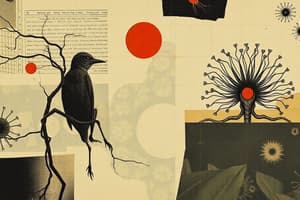Podcast
Questions and Answers
What happens to the oocyte after fertilization?
What happens to the oocyte after fertilization?
- It undergoes changes that prevent polyspermy (correct)
- It starts to form a blastula
- It begins to form a morula
- It begins to divide by meiosis
What is the primary function of gametogenesis?
What is the primary function of gametogenesis?
- Formation of gametes (correct)
- Formation of tissues
- Formation of somatic cells
- Formation of organs
During what stage of development does the embryo grow into a fetus?
During what stage of development does the embryo grow into a fetus?
- During the third trimester
- Towards the end of the first trimester (correct)
- During the first trimester
- During the second trimester
What is the process by which the three germ layers are formed?
What is the process by which the three germ layers are formed?
What is the result of capacitation in sperm?
What is the result of capacitation in sperm?
What is the term for the process of fertilization by more than one sperm?
What is the term for the process of fertilization by more than one sperm?
What is one of the main reasons why asexual reproduction is not ubiquitous?
What is one of the main reasons why asexual reproduction is not ubiquitous?
What is the main difference between aquatic and terrestrial vertebrate reproduction?
What is the main difference between aquatic and terrestrial vertebrate reproduction?
What is the function of the acrosome in male gametes?
What is the function of the acrosome in male gametes?
What is the result of a decrease in estradiol and progesterone from the ovaries in women?
What is the result of a decrease in estradiol and progesterone from the ovaries in women?
What is the main difference between r-strategists and k-strategists?
What is the main difference between r-strategists and k-strategists?
What is the function of the hypothalamus in the reproductive system?
What is the function of the hypothalamus in the reproductive system?
What process reduces the number of chromosomes in gametes during sexual reproduction?
What process reduces the number of chromosomes in gametes during sexual reproduction?
What is the result of the fusion of gametes during sexual reproduction?
What is the result of the fusion of gametes during sexual reproduction?
What type of reproduction involves the production of clones?
What type of reproduction involves the production of clones?
Which of the following is NOT a type of asexual reproduction?
Which of the following is NOT a type of asexual reproduction?
What is the two-fold cost of sex?
What is the two-fold cost of sex?
Why are there few organisms that only reproduce asexually in the animal kingdom?
Why are there few organisms that only reproduce asexually in the animal kingdom?
Flashcards are hidden until you start studying
Study Notes
Reproductive Development
- Gametogenesis is the formation of gametes (sperm and ova)
- Spermatogenesis is the formation of sperm, while oogenesis is the formation of ova (or eggs)
Sperm Development
- During coitus, sperm is introduced into the female reproductive tract
- In the female reproductive tract, sperm undergo capacitation, which increases motility, loses membrane proteins, and changes plasma membrane fluidity
Fertilization and Development
- After fertilization, the oocyte completes meiosis II and undergoes changes to prevent polyspermy
- The single-celled zygote then divides by mitosis (cleavage) to increase the number of cells without increasing embryo size
- The morula stage is a solid ball of cells, while the blastula stage is a fluid-filled ball of cells
- Implantation marks the beginning of pregnancy
- The blastocyst grows into a bilaminar embryo and undergoes gastrulation, forming the three germ layers: ectoderm, mesoderm, and endoderm
- The trilaminar embryo then undergoes organogenesis, during which organs are formed
Evolution of Reproduction
- Hypotheses for why asexual reproduction is not ubiquitous include:
- Beneficial mutations can be spread through the population via sex
- Harmful mutations can be purged via sex
- The Red Queen Hypothesis
Vertebrate Reproduction
- Aquatic vertebrates (fish and amphibians) use external fertilization
- Terrestrial vertebrates (reptiles, birds, and mammals) use internal fertilization
- Amniotic eggs evolved to allow terrestrial animals to lay eggs outside of water
Reproductive Strategies
- r-strategists produce many offspring with minimal parental investment
- k-strategists produce few offspring with high parental investment
Male Gametes
- Produced in the testes
- Anatomy consists of head (acrosome), neck (mitochondria), and tail (flagellum)
Female Gametes
- Produced in the ovaries
- Travel through the oviduct (fallopian tube) where fertilization usually occurs
- Fertilized ovum implants in the uterus to develop
Hormone Control of the Reproductive System
- Hypothalamus releases gonadotropin-releasing hormone, which triggers the release of luteinizing hormone (LH) and follicle-stimulating hormone (FSH)
- LH and FSH trigger the release of testosterone, estrogen, and progesterone
- Hormones control the development of secondary sexual characteristics and the menstrual cycle in females
- Decrease in estradiol and progesterone from the ovaries leads to menopause in women
Studying That Suits You
Use AI to generate personalized quizzes and flashcards to suit your learning preferences.




